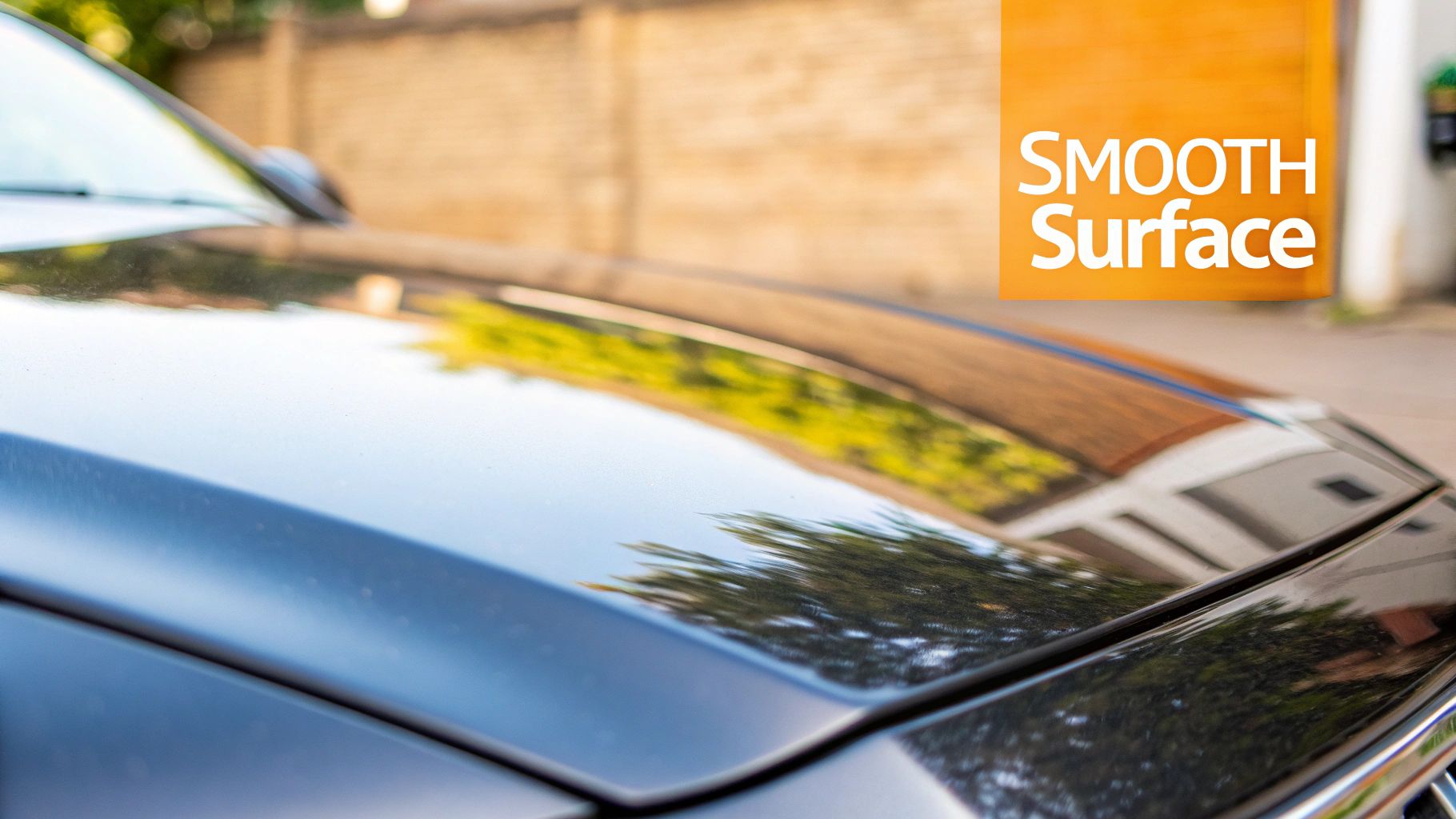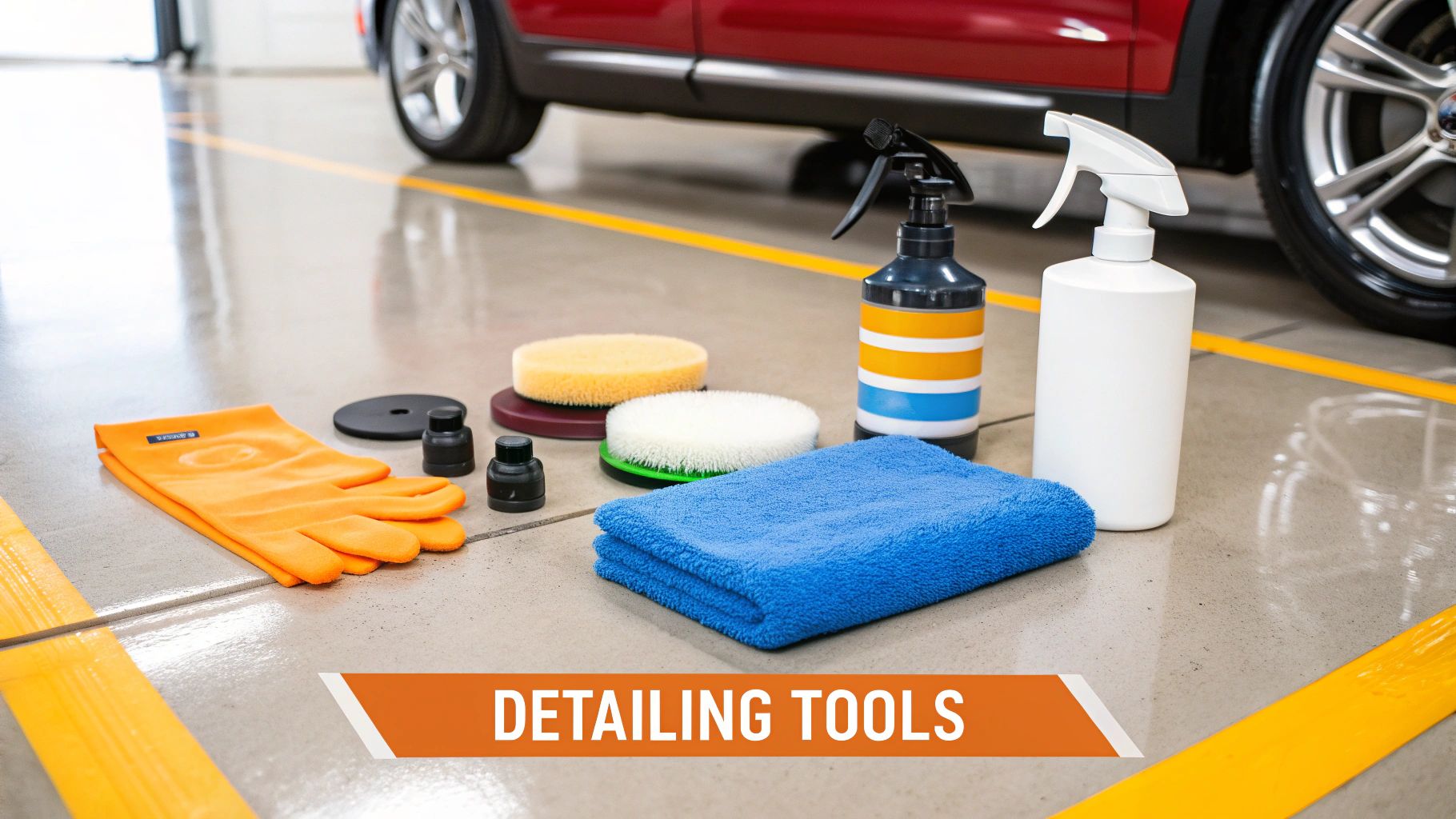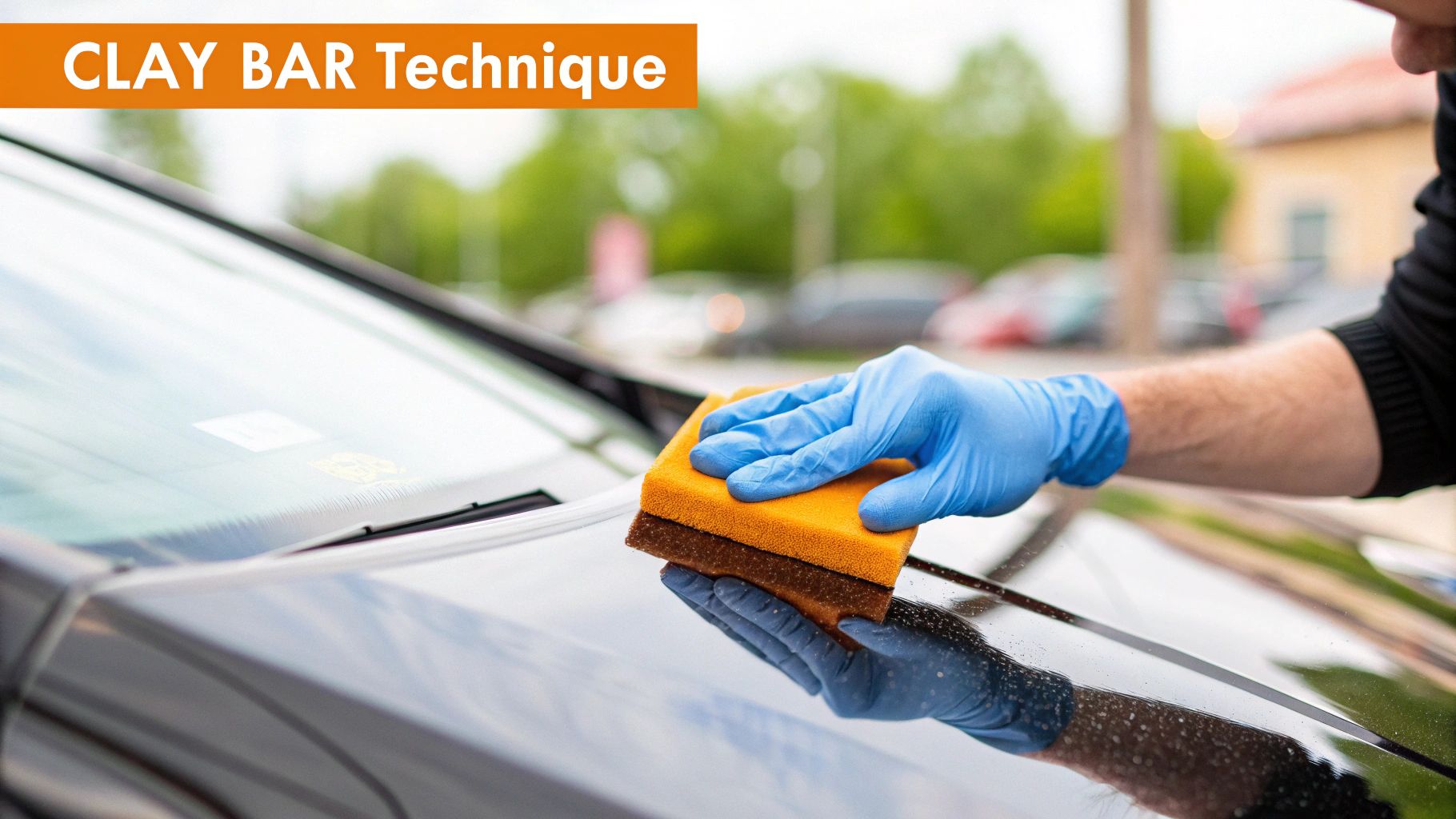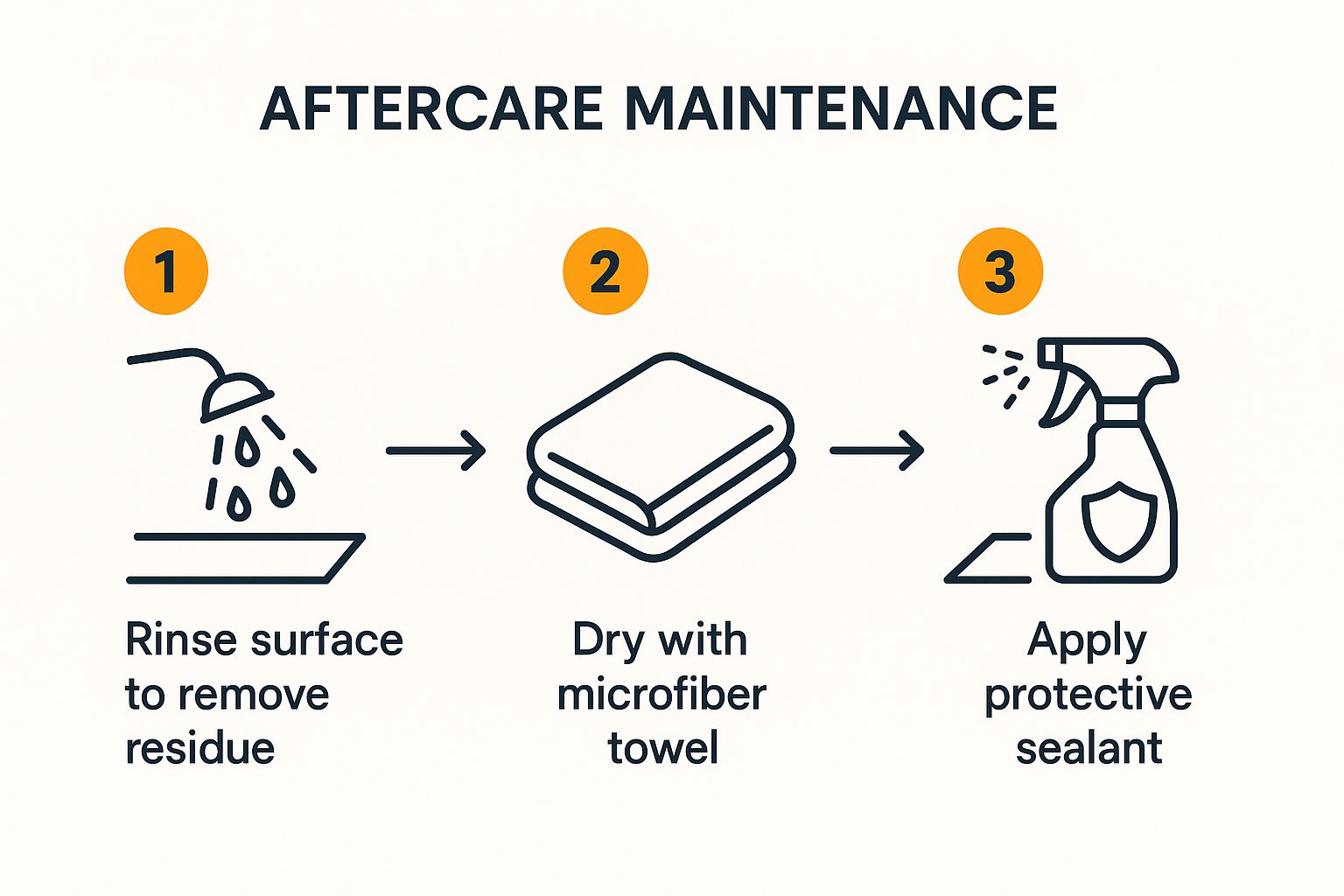Ever run your hand over your car's paint right after a wash and felt little bumps? It feels clean, but not truly smooth. That's where a clay bar comes in.
Clay barring is a deep-cleaning process that lifts and removes stubborn contaminants embedded in your car's clear coat. It's not about scrubbing hard; it’s a gentle but effective way to pull out the grime that washing simply can't touch, leaving the surface perfectly prepped for polishing and protection.
What a Clay Bar Actually Does for Your Car's Paint
Think of your car’s paint like your skin—it has microscopic pores. Over time, those pores get clogged with all sorts of nasty stuff: brake dust, industrial fallout, and tree sap. These particles bond to the surface and won't come off with a simple wash.
A detailing clay bar is a specially designed resin compound that works like a magnet for these contaminants. It's not abrasive. Instead, when you glide it over a lubricated surface, its tacky nature grabs onto anything sticking up from the paint and pulls it out safely.
This process is less about cleaning and more about decontaminating. A truly clean surface is the foundation for everything else. Waxes, sealants, and ceramic coatings need to bond directly to the clear coat, and they can't do that if a layer of grit is in the way.
So, what kind of gunk are we talking about?
- Industrial Fallout: Tiny metal specks from railways and factories that can actually rust on your paint.
- Brake Dust: Sharp, metallic bits that fly off your wheels and embed themselves into the finish.
- Tree Sap and Tar: Sticky, stubborn residues that a normal wash just smears around.
- Paint Overspray: A fine mist from a nearby paint job that settles and hardens on your car.
Here’s a quick look at the kind of transformation you can expect.
Paint Condition Before vs After Clay Barring
This table gives you a clear, side-by-side comparison of the immediate impact a clay bar treatment has on your car's exterior.
| Paint Attribute | Before Clay Bar Treatment | After Clay Bar Treatment |
|---|---|---|
| Texture | Gritty or rough to the touch, even after washing. | Silky smooth, like glass. |
| Appearance | May look dull or have tiny, visible specks. | Visibly cleaner with enhanced clarity and gloss. |
| Sound | Rubbing a finger across the paint sounds scratchy. | Silent when you glide your hand across the surface. |
| Protection | Waxes and sealants sit on top of contaminants. | Waxes and sealants bond directly to the paint. |
The difference is night and day. Once you feel that perfectly smooth surface, you'll never skip this step again.
By pulling out all that embedded grit, the clay bar restores that slick, glass-like feel your paint had when it was new. This creates the ideal canvas for the next stage of detailing. To see what comes next, you can learn more about how to polish car paint and understand why starting with a decontaminated surface is non-negotiable for achieving a flawless shine.
The Invisible Grime a Clay Bar Grabs
Ever washed your car, only to run your hand over the paint and feel a gritty, rough texture? That’s not dirt you missed. It’s a layer of bonded contaminants that soap and water just can’t touch.
These tiny particles are the sworn enemy of a glossy finish, and they’re what a clay bar is designed to eliminate. Getting a feel for what you're actually pulling off the paint helps you understand why this step is so critical for your car's long-term health.
Industrial Fallout and Environmental Gunk
First up is the stuff you can’t even see falling. Think of it as industrial and environmental fallout. This includes tiny metal specks from railway lines, often called rail dust, and airborne pollutants from factories.
These particles land on your car and embed themselves in the clear coat. Over time, the metal bits can actually start to rust, leaving behind those frustrating little orange spots that seem impossible to get rid of.
Natural Deposits and Road Grime
Nature has its own ways of messing with your paint. Hardened tree sap is a classic example, sticking like glue and becoming a real headache to remove. If you're dealing with a particularly stubborn patch, our guide on how to remove tree sap from a car breaks down the best techniques.
Mineral deposits from hard water are another problem. When water evaporates, it leaves minerals behind that can etch into your clear coat, creating permanent spots if you don't deal with them.
And let's not forget everyday road grime. This isn't just mud. It’s the tar and asphalt flecks that get flung from the road surface and bake onto your paint, especially along the lower parts of your car. These create a rough, bumpy surface that no amount of scrubbing will smooth out.
Think of a clay bar as a powerful magnet for everything stuck in your paint, not just sitting on it. A regular wash cleans the surface, but a clay bar goes deeper to pull out the embedded gunk that causes real damage.
This is why claying is so important. It physically lifts away everything from brake dust to overspray, restoring a perfectly smooth foundation. Your paint won't just look better; it will feel glassy-smooth, ready for wax or sealant to properly bond and protect it. To see just how much this step can protect your investment, check out these insights on the benefits of clay bar treatments on HarmonyDetails.com.
How Does a Clay Bar Actually Work?
So, how can a simple lump of what looks like putty work such wonders without scratching your car's delicate paint? It’s all about what the clay is made of and, just as importantly, how you use it. An automotive clay bar isn't your kid's modeling clay. It's a specially engineered resin compound designed with a very specific job in mind.
This compound is just abrasive enough to grab onto nasty contaminants but gentle enough that it won't harm your car's clear coat.

The real magic happens when you pair the clay with a good lubricant. As you spray the lubricant on a panel and glide the bar across, it feels almost frictionless. It's a lot like using shaving cream with a razor—the lube creates a slippery barrier, preventing the clay from dragging and potentially marring the finish. Trying to use a clay bar dry is a recipe for disaster.
Shearing Off Contaminants
As you move the lubricated bar across the paint, its slightly sticky surface grabs hold of anything poking up from the surface. Think of it as a super-fine "shave" for your car's paint. This abrading action physically shears off the bonded gunk from the clear coat.
A clay bar doesn't dissolve contaminants with chemicals. Instead, it physically plucks them from the surface and traps them inside its soft body, which keeps that grit from scratching the rest of your paint.
This is exactly why you have to constantly fold and knead the clay as you work. By folding it over, you expose a fresh, clean part of the bar and trap the junk you just removed deep inside. This stops you from dragging that collected grit all over the next panel.
This whole process boils down to three key actions:
- Lifting the Grime: The clay physically pulls out particles that regular washing and chemical sprays leave behind.
- Trapping the Debris: It safely wraps up those sharp particles within the clay itself, getting them off your car for good.
- Protecting the Paint: When done right with plenty of lube, the process leaves the underlying clear coat completely untouched and smooth.
This is the real answer to "what does clay barring do?" It's a mechanical cleaning process that safely gets rid of embedded contamination, leaving you with a perfectly smooth surface that's ready for polishing and waxing.
The Real-World Benefits of Clay Barring Your Car
So, we've talked about what a clay bar is and how it works. But what does that mean for your car in the real world? The results are something you can both see and feel, and they lay the groundwork for a truly flawless finish. This isn't just another cleaning step; it's about restoring your paint to its absolute best.
The very first thing you’ll notice is the texture. Run your hand over a panel after it’s been properly clayed, and you'll be amazed. The surface feels unbelievably smooth and slick—like glass. That tactile smoothness is your first clue that you’ve created the perfect canvas for a deep, brilliant shine.

Enhanced Shine and Reflection
Think about how light reflects off a perfectly still lake versus a choppy one. Your car's paint works the same way. When it's covered in tiny, gritty contaminants, light scatters in every direction, which is why the finish looks dull.
By shearing off that microscopic layer of grime, you create a perfectly flat surface. Light can now bounce back uniformly, giving you that sharp, vibrant gloss that makes your car’s color look deeper and richer. It’s a night-and-day difference.
This isn’t just subjective, either. Some studies have shown that using a clay bar can lead to up to a 30% increase in surface gloss when compared to just washing and waxing. That's a serious improvement, and it all comes from getting the paint truly clean.
Superior Protection and Longevity
Here’s arguably the most important benefit: clay barring makes your wax, sealant, or ceramic coating work so much better. These protective products are meant to bond directly to your car’s clear coat.
When your paint is contaminated, your wax is just sitting on top of a layer of dirt. It can't form a strong bond, which means its protective qualities and lifespan are seriously compromised.
By giving your protectants a perfectly clean slate to stick to, you get some huge advantages:
- Longer Lasting Wax: Your favorite wax or sealant will adhere properly, protecting your finish for weeks or even months longer than it would on a contaminated surface.
- More Effective Shielding: The protective layer is more complete and uniform, giving you a stronger shield against UV rays, acid rain, and all the other gunk the road throws at your car.
Ultimately, proper paint care like clay barring is a critical step to make your car last longer and hold onto its value.
How to Know When Your Car Needs a Clay Bar Treatment
So, how often should you actually use a clay bar? Forget what the calendar says. The real answer is simple: your car will tell you when it's time.
While some detailers might suggest a treatment once or twice a year, that's just a starting point. The environment your car lives in is the biggest factor. Do you park under a sappy tree every day? Or maybe you live near an industrial area with a lot of fallout? If so, you'll probably need to clay more often.

Try the Plastic Bag Test
There’s a classic detailer's trick for this, and it’s foolproof. It's called the "plastic bag test," and it lets you feel what your eyes can't see.
First, give your car a good wash and dry. Then, slip a thin plastic sandwich bag over your hand and gently run your fingertips across the paint—try the hood, roof, and door panels.
If you feel tiny bumps and a gritty, sandpaper-like texture, that's your sign. Those are the bonded contaminants that washing alone couldn't remove. It's definitely time for a clay bar.
The plastic bag heightens your sense of touch, making even the smallest particles impossible to miss. If the surface feels perfectly smooth, like glass, you can hold off for now.
For most cars in average conditions, 2 to 3 times per year is a good rule of thumb. But again, let the feel of the paint be your ultimate guide. You can get more professional tips on maintaining your car's paint on HarmonyDetails.com. When in doubt, the plastic bag test never lies.
Where Clay Barring Fits in Your Detailing Process
In the world of car detailing, order is everything. Get the steps wrong, and you'll not only waste a ton of time but could actually make your paint look worse. Clay barring isn't step one, and it certainly isn't the final touch. It’s the crucial link that turns a simple car wash into a full-blown paint restoration.
Think about it like this: you wouldn't slap a fresh coat of paint on a wall without sanding and priming it first, right? The same logic applies here. Applying a wax or sealant over a gritty, contaminated surface just traps all that junk underneath. You're essentially sealing in the problem.
Clay barring prepares the canvas. It creates that perfectly smooth, clean foundation that allows your polish and wax to do their job properly.

The Correct Detailing Order
So, where does claying fit in? It sits right in the middle—after you've washed the car but before you even think about adding protection. Getting this sequence right is the secret to a professional-grade finish.
To help you visualize where clay bar treatment fits into the bigger picture, here is the proper workflow for tackling your car's exterior. Following this order ensures each step builds perfectly on the last one.
The Proper Car Detailing Workflow
Learn where clay bar treatment fits into the complete exterior car care process for optimal results.
| Step Number | Action | Why It's Important |
|---|---|---|
| Step 1 | Wash and Dry | Removes all the loose dirt and surface grime. You never want the clay bar dragging large particles across the paint, as this can cause scratches. |
| Step 2 | Chemical Decontamination | An optional but highly recommended step. Using an iron or tar remover dissolves stubborn contaminants chemically, giving the clay bar less work to do. |
| Step 3 | Clay Bar Treatment | With the surface clean, the clay can now safely pull out all the embedded grit that washing couldn't touch, leaving the paint silky smooth. |
| Step 4 | Polish and Protect | Now that the paint is perfectly clean, it's ready for polishing (to remove swirls) and a final layer of wax or sealant to lock in the shine. |
This process ensures you aren't working against yourself. By claying after washing, the bar can focus on the tough stuff. By claying before waxing, you guarantee that your protective coating bonds directly to the clear coat for a stronger, longer-lasting shield.
Understanding the workflow is a key part of any good maintenance routine. For a complete overview of how this fits into overall vehicle care, check out this ultimate car maintenance checklist.
And if you’re looking to build out your toolkit, this guide to essential https://www.swiftjetusa.com/blogs/news/auto-detailing-equipment-list-must-have-tools-for-2025 will get you started. The final takeaway is simple: claying leaves your paint totally bare and exposed, so following up with a quality wax or sealant isn't just recommended—it's absolutely necessary.
Common Questions About Clay Barring
Even after you get the hang of what a clay bar does, a few practical questions always seem to come up. Getting these details right is the key to a perfect finish and avoiding some common, paint-damaging mistakes.
Let's dive into some of the questions I hear all the time from car owners.
Can a Clay Bar Remove Scratches?
Absolutely not. A clay bar is designed to pull contaminants off the surface of your paint—it cannot remove scratches, swirls, or etchings, which are defects in the paint.
Think of it this way: claying is like deep-cleaning the pores of your skin. Polishing is what actually corrects imperfections. While a super-clean surface might make some minor blemishes less obvious, you'll need a polish to actually fix them.
A clay bar decontaminates; a polish corrects. They are two different tools for two very different jobs.
What Happens If I Drop My Clay Bar?
If your clay bar hits the ground, it’s done. Throw it away immediately, no questions asked.
The moment it touches the floor, it picks up sharp bits of grit and dirt. Using it after that is basically like rubbing fine-grit sandpaper all over your car's finish, and you'll cause some serious scratching. It's just not worth the risk for the price of a new piece of clay.
Can I Use Soap and Water as Lubricant?
You really shouldn't. While it might seem like a good idea, regular car soap and water just don't cut it.
A proper clay lubricant or a good quality detailing spray is engineered to be incredibly slick, allowing the clay to glide effortlessly. Soaps can get sticky, or even worse, they can start to break down the clay itself. This creates more friction, which is exactly what you don't want, as it can mar the paint you're trying to perfect.
